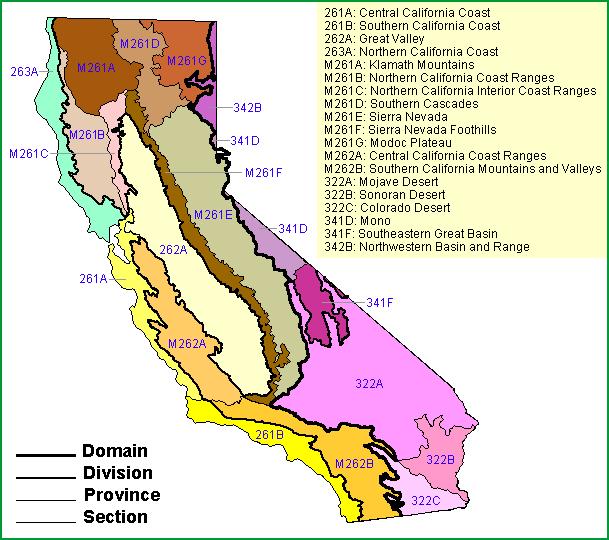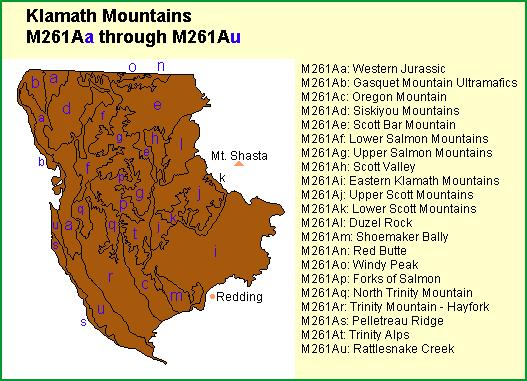 | Klamath Mountains |
|
|
http://www.fs.fed.us/r5/projects/ecoregions/m261a.htm
Section M261A
Klamath Mountains
The Klamath Mountains section is between the Southern Cascade Mountains and the Coast Range mountains. Its southern limit is the northern end of the Great Valley. The section is mostly in MLRA 5, with some hot and relatively dry valleys in MLRA 21.
Geomorphology. Uplifted and dissected peneplain on strong rocks; extensive monadnock ranges. Mountains in this section have accordant or subequal summits and are generally, but not consistently, aligned north-south. Elevations of accordant summits increase from west to east as far as the Eastern Klamath Belt where this trend continues eastward only on the Trinity Ultramafic Sheet. Klamath Mountains geomorphic province.
Lithology. Paleozoic sedimentary and volcanic rocks, and Mesozoic ultramafic, granitic, sedimentary and volcanic rocks.
Soil Taxa. Alfisols, Entisols, Inceptisols, Mollisols and Ultisols in combination with thermic, mesic, frigid or cryic soil temperature regimes and xeric or aquic soil moisture regimes.
Vegetation. Predominant potential natural communities include the Douglas-fir series, Douglas-fir - tanoak series, Jeffrey pine series, Mixed conifer series, White fir series, Douglas-fir - ponderosa pine series, Canyon live oak series, Oregon white oak series, Mixed chaparral shrublands, Red fir series and Mixed subalpine forest series.
The following series are found throughout the section and are not restricted to or extensive in any subsection. Series dominated by exotic plants are not placed in subsections unless they are extensive and stable.
Series dominated by exotic plants: Broom series, Cheatgrass series, and Kentucky bluegrass series.
Series that can occur in all subsections, but are not extensive: Beaked sedge series, Bulrush series, Bulrush - cattail series, Bur-reed series, Cattail series, Creeping ryegrass series, Duckweed series, Idaho fescue series, Introduced perennial grassland series, Mosquito fern series, One-sided bluegrass series, Pondweeds with floating leaves series, Pondweeds with submerged leaves series, Quillwort series, Sedge series, Spikerush series, and Tufted hairgrass series.
Series restricted to riparian settings: Arroyo willow series, Black cottonwood series, Fremont cottonwood series, Mixed willow series, Montane wetland shrub habitat, Mulefat series, Narrowleaf willow series, Pacific willow series, Red willow series, Sandbar willow series, and White alder series.
Disturbance series of short-lived vegetation: Blue blossom series, Deerbrush series, Greenleaf manzanita series in part, Mountain whitethorn series, Tobacco brush series in part, Sadler oak in part, and Wedgeleaf ceanothus series in part.
Fauna. Mammals include Roosevelt elk, black-tailed deer, black bear, mountain lion, coyote, bobcat, ringtail, marten, fisher and river otter. Birds include eagles, hawks, owls, peregrine falcon, osprey and ruffed grouse. Species of concern include marbled murrelet and northern spotted owl. Streams and rivers are used by anadromous fish.
Elevation. 200 to 9,000 feet.
Precipitation. 18 to 120 inches.
Temperature. 30░ to 57░F.
Growing Season. 25 to 225 days.
Surface Water Characteristics. Many rapid or moderately rapid flowing rivers and streams. Most rivers flow westerly in deeply incised canyons with bedrock controlled channels. Some easterly flowing streams in deeply incised canyons flow inland to the Sacramento River. Some water is diverted from the westward flowing Trinity River system eastward to the Sacramento River. Numerous lakes and meadows associated with glaciated areas above 5,000 feet.
Disturbance Regimes.
Fire: At lower and mid-elevations, historic occurrence has changed from frequent, low intensity ground fires to infrequent, high intensity stand replacing fires. At higher elevations, historic occurrence has changed from infrequent, low and moderate intensity ground fires to infrequent, low, moderate and high intensity surface or stand replacing fires.
Seismic Activity: Western part is seismically active area with strong shaking and ground rupture.
Climate: Wide fluctuations in precipitation and temperature for periods of years result in significant or catastrophic changes in biological communities. Landslides initiated by climatic, seismic and human events are common in steep areas of the section.
Land Use. Composition and successional sequence of some communities has changed because of plant and animal species introduced between the mid 1800''s and early 1900''s related to mining, grazing, forestry and recreational activities.
Cultural Ecology. Humans have been utilizing the Klamath Mountains for about 8,000 years, and have been an integral part of the ecology for 2,000 to 3,000 years. The western portion of the Klamath Mountains lies in the Northwest California culture area; the diversity of Northwest California ethnographic cultures is the most complex in the United States, reflecting diverse prehistoric and historic uses, practices, and human adaptations. Early Euroamerican influences and settlement came from mining booms concomitant with the Gold Rush. Contemporary attitudes and beliefs tend to be dominated by commodity oriented long-time resident values and a rural lifestyle. The economy is dominated by government employment, but the timber industry and recreation are also important.
Subsections. The Klamath Mountains section is divided into 21 subsections.

